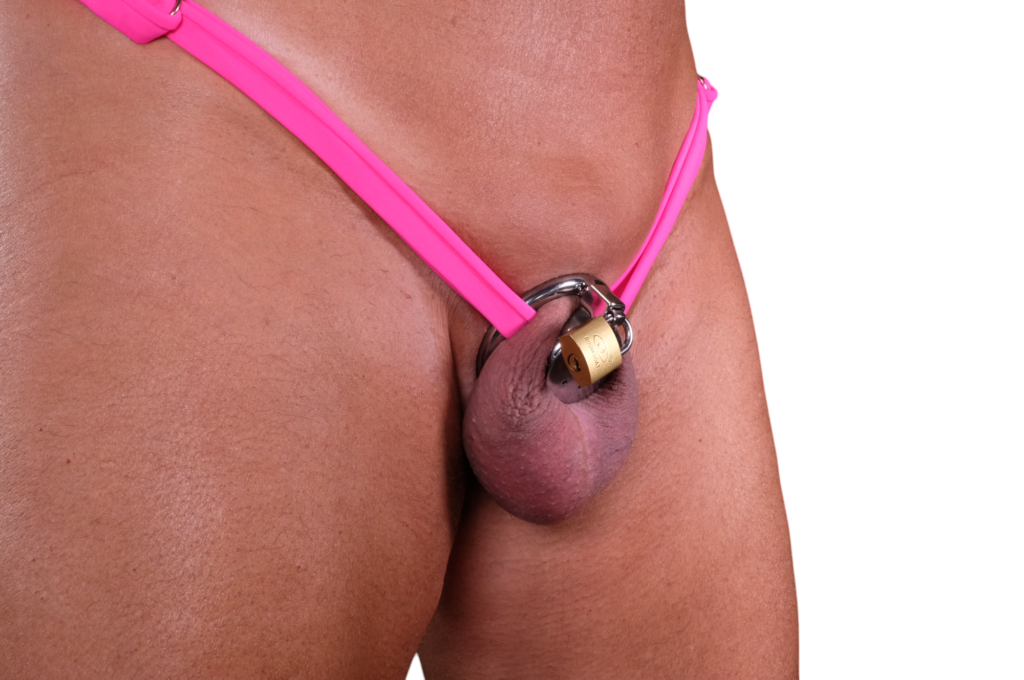Understanding Male Chastity Cages
Male chastity cages are devices worn around the penis to prevent erections or sexual activity, typically used for kink, discipline, or lifestyle purposes. Choosing the right chastity cage depends on your anatomy, comfort, and goals. Here’s a breakdown of the types and materials available:

Types of Male Chastity Cages
- Full-Size Male Chastity Cages
- Best for: Men with average to larger penis sizes.
- Features: Full-length cages enclose the entire shaft and tip of the penis.
- Benefits: These provide a snug fit for longer wear and often have ventilation holes or slots for hygiene. They are ideal for those new to chastity devices or those who want a more traditional look and feel.
- Drawbacks: May be more visible under clothing due to their size.
- Mini Male Chastity Cages
- Best for: Men with smaller penis sizes or those who prefer a more discreet device.
- Features: Shorter cages that compress the shaft partially but not entirely.
- Benefits: Easier to wear for extended periods and less noticeable under clothing. These also reduce the chance of discomfort from erections.
- Drawbacks: Might feel tight for men with larger anatomy.
- Micro Male Chastity Cages
- Best for: All penis sizes but specifically designed for those who enjoy significant compression or denial.
- Features: Extremely short cages that leave little to no room for the shaft to extend, even during arousal.
- Benefits: Maximum restriction and minimal visibility under clothing. Provides a psychological and physical sense of confinement.
- Drawbacks: Can require adjustment and experience to avoid discomfort.
- Inverted Male Chastity Cages
- Best for: All penis sizes, especially for users interested in extreme chastity or a “tucked” aesthetic.
- Features: These push the shaft into the body cavity, leaving the tip or a portion exposed (or sometimes entirely concealed).
- Benefits: Ideal for those pursuing total concealment or gender play. Offers a unique feeling and a sense of deep restriction.
- Drawbacks: Can feel unnatural to some and may require careful sizing to avoid pressure on internal tissues.
Materials for Male Chastity Cages
Choosing the right material affects comfort, hygiene, and security. Here’s a breakdown of common materials:
- Stainless Steel
- Most popular material.
- Advantages:
- Durable and long-lasting.
- Easy to clean and highly resistant to rust or corrosion.
- Provides a heavier feel, enhancing the sense of restriction.
- Disadvantages:
- Heavier than other materials, which some may find uncomfortable for extended wear.
- Can be colder to wear initially but warms up with body heat.
- Silicone
- Advantages:
- Soft and flexible, making it ideal for beginners or those seeking comfort.
- Lightweight and discreet under clothing.
- Disadvantages:
- Less secure than steel, as it can be stretched.
- Can be harder to clean thoroughly due to its porous nature.
- Advantages:
- Plastic
- Including 3D-printed and resin options.
- Advantages:
- Lightweight and available in various designs.
- Ideal for travel as they often come with non-metallic locks.
- Typically more affordable.
- Disadvantages:
- Less durable than steel.
- May crack or warp over time, especially with extended use.
- Resin
- Advantages:
- Lightweight and smooth, offering comfort during prolonged wear.
- Comes in a variety of colors and designs.
- Disadvantages:
- Can be more brittle and less durable than other materials.
- Advantages:
- Other Materials
- Features: Some cages are made from exotic materials like titanium (lightweight yet durable) or carbon fiber (strong and light but expensive).
- Considerations: These are niche options and may not be widely available but can provide unique benefits for enthusiasts.
Choosing the Right Chastity Cage for You
To find the right cage, consider these factors:
- Size and Fit
- Measure your flaccid length and girth to ensure the cage fits snugly without being too tight.
- A properly fitted cage prevents discomfort and minimizes the risk of injury.
- Material Preference
- Beginners may prefer silicone or plastic for comfort.
- Advanced users often prefer stainless steel for security and durability.
- Purpose
- Determine your goals: Are you seeking total denial, extended wear, or discreet daily use?
- For gender exploration, inverted cages may be ideal.
- Hygiene
- Choose designs with ventilation holes or slots for easier cleaning and better airflow.
- Discretion
- If you need a device that’s less noticeable, opt for mini or micro cages made from lightweight materials like silicone or resin.
Final Tips
- Start Simple: If you’re new to chastity, consider starting with a silicone or lightweight plastic cage to get used to the sensation.
- Experiment: Don’t be afraid to try different types and sizes to find what works best for you.
- Listen to Your Body: Discomfort can signal that the cage isn’t the right size or fit. Always prioritize safety.
By carefully considering your anatomy, material preferences, and intended use, you’ll be well on your way to selecting a male chastity cage that’s perfect for you!